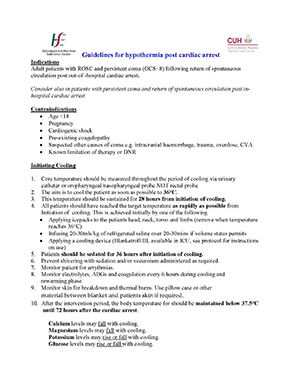Background
TTM after cardiac arrest (CA) improves neurologically intact survival.
Potential mechanisms include: avoiding hyperthermia, ↓ metabolic demand, ↓ hyperperfusion post ischaemia, minimising loss of cererbral autoregulation (and blood-brain-barrien disruption) and ↓ intracranial hypertension.
Aim for 36°c.
Indications
Adult patients with persistent coma following ROSC post cardiac arrest.
Contraindications
- Age <18
- Pregnancy
- SBP <90mmHg
- Pre-existing coagulopathy
- Suspected other causes coma e.g. trauma, OD, CVA
- Known limitation of therapy or DNR
Cooling Technique

- Core temperature should be measured throughout the period of cooling via urinary catheter or oropharyngeal/nasopharyngeal probe, not rectal probe
- The aim is to cool the patient as soon as possible to 36°C
- This temperature should be sustained for 28 hours from initiation of cooling
- All patients should have reached the target temperature as rapidly as possible from initiation of cooling. This is achieved initially by one of the following:
- Applying icepacks to the patients head, neck, torso and limbs (remove when temperature reaches 36°C)
- Infusing 20-30mls/kg of refrigerated saline over 20-30mins if volume status permits
- Applying a cooling device (Blanketroll III, available in ICU, see protocol for instructions on use)
- Patients should be sedated for 36 hours after initiation of cooling
- Prevent shivering with sedation and/or Vecuronium administered as required
- Monitor patient for arrhythmias
- Monitor electrolytes, ABGs and coagulation every 6 hours during cooling and rewarming phase
- Monitor skin for breakdown and thermal burns. Use pillow case or other material between blanket and patients skin if required
- After the intervention period, the body temperature for should be maintained below 37.5°C until 72 hours after the cardiac arrest.
Calcium levels may fall with cooling.
Magnesium levels may fall with cooling.
Potassium levels may rise or fall with cooling.
Glucose levels may rise or fall with cooling.
Re-warming procedure
- After 28 hours, gradual rewarming to 37°C in hourly increments of 0.5°C. Use cooling device to rewarm patient. Do not remove the blanket to allow the patient to rewarm passively
- Each hour increase the cooling blanket "setpoint" temperature by 0.5°C (to maximum setpoint of 37 °C). Press the "temperature set" switch, use the up arrow to increase the "setpoint" by 0.5°C
- Press the "gradient variable" button. Please refer to Blanketroll III protocol for instructions on use
- Monitor electrolytes, ABGs and coagulation during and post rewarming
Monitor
Monitor closely during and a minimum of 24 hrs post rewarming for:
- Seizures
- Rebound hyperthermia
- Acidosis
- ↓Ca++, ↓Mg++
- Hypoglycaemia
- Hyperkalaemia
- Diuresis/oliguria
- Vasodilation and ↓BP
References
- https://lifeinthefastlane.com/ccc/therapeutic-hypothermia-after-cardiac-arrest/
- Nielsen, N., Wetterslev, J. et al. Targeted Temperature Management at 33°C versus 36°C after Cardiac Arrest. NEMJ 369; 2197-206
- Bernard S, Gray T, Buist M et al. Treatment of comatose survivors of out-of –hospital cardiac arrest with induced hypothermia. NEJM 2002;346:557-63
- The Hypothermia after cardiac arrest study group. Mild therapeutic hypothermia to improve the neurological outcome after cardiac arrest. NEJM 2002; 346:459-56
- NICE Guideline March 2011 IPG386- Therapeutic hypothermia following cardiac arrest